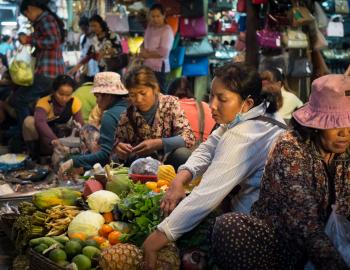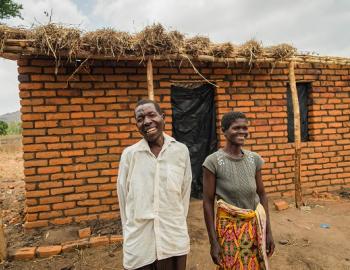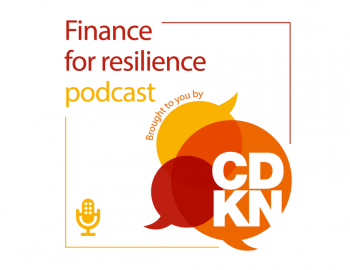Inside Story : Mainstreaming climate resilience into government - the Philippines Climate Change Act
Inside Story : Mainstreaming climate resilience into government - the Philippines Climate Change Act
The Philippines is at high risk from rising sea levels and from a projected increase in severe tropical storms because of its geography and location. Seventy percent of its cities and towns are on the coast. The vulnerability of its population to climate change is made worse by high poverty levels, and also by the negative environmental and social impacts of the country’s large natural-resource extraction industries such as mining and logging.
To increase its resilience to climate change, the Philippines has recently implemented a strong, coordinated strategy to mainstream climate compatible development into local planning. The Philippines’ Climate Change Act establishes a legal and institutional framework for climate change governance. It mainstreams climate resilience into government mandates across sectors – and seeks to capture the greatest benefits from climate finance for both adaptation and mitigation.
The Climate Change Commission, the central coordinating body for implementing the Act, reports to the country’s President – raising climate change adaptation and mitigation to the highest political level. Local government units develop and implement Local Climate Change Action Plans, which prioritise local needs and integrate best practices into development activities.
In this CDKN Inside Story: Mainstreaming climate resilience into government - the Philippines Climate Change Act, Katherine Lofthouse and Alex Kenny of the Centre for International Sustainable Development Law (CISDL) explores what it will take for this leading-edge climate programme to succeed. They conclude that the successful devolution of climate change strategies to the local government level will require effective coordination and support at the national level, through finance and capacity building.
This publication is one of a series of policy briefs that explore the Inside Stories on climate compatible development.
Image courtesy Panos.
Mainstreaming climate resilience into government – the Philippines Climate Change Act
Because of its geography and location, the Philippines is at high risk from rising sea levels and from a projected increase in severe tropical storms; 70% of its cities and towns are on the coast. The vulnerability of its population to climate change is exacerbated, not only by high poverty levels, but also by the negative environmental and social impacts of the country’s large natural resource extraction industries.
To increase its resilience to climate change, the Philippines has recently implemented a strong and coordinated strategy to mainstream climate compatible development into local planning. This may have been prompted by the devastating impacts of Typhoon Ketsana in 2009, which caused over 700 fatalities and $1 billion in damages, severely affecting Metro Manila and 25 provinces. A further factor may be lobbying by civil society organisations (CSOs) for the Government to take action to reduce vulnerability to such extreme events.
In 2009 the Government passed the Climate Change Act, establishing a legal and institutional framework for climate change governance and mainstreaming climate resilience into government mandates across sectors. The Act also created the Climate Change Commission as the sole policy-making authority on climate change, replacing the overlapping mandates of the Inter- Agency Committee on Climate Change and the Presidential Task Force on Global Warming and Climate Change.
While there are lessons to be learnt from the Philippines’ coordinated response to climate change, the success of this approach will be affected by how other government development policies can be re-oriented in a more sustainable direction.
The Climate Change Act
The structure of the Climate Change Act ensures that accountability for climate action reaches the highest political level – the country’s President – who serves as Chairperson of the Climate Change Commission. This body consists of three commissioners assisted by a Climate Change Office, a National Panel of Technical Experts and an Advisory Board.
To benefit from a broad base of knowledge and expertise, the Advisory Board is comprised of representatives from several government agencies and local government units (LGUs), as well as representatives from academia, business and non-government organisations. The Act requires at least one representative from the disaster risk reduction community.
A Joint Congressional Oversight Committee, composed of five senators and five house representatives, monitors the Act’s implementation. The Climate Change Commission must submit annual progress reports to the President and to both Houses of Congress, although the Oversight Committee can request a report at any time.
The Framework Strategy and the Action Plan
The Commission developed a National Framework Strategy on Climate Change in 2010 and a National Climate Change Action Plan in 2011. The Framework Strategy serves as a roadmap for increasing the country’s social and economic adaptive capacity, the resilience of its ecosystems, and the best use of mitigation and finance opportunities. The Action Plan, finalised in November 2011, outlines programmes of action for climate change adaptation and mitigation. It identifies the communities and areas most vulnerable to adverse impacts and considers differential impacts on women, children and marginalised populations.
The Action Plan addresses seven priority areas: food security; water sufficiency; ecosystem and environmental stability; human security; sustainable energy; climate-smart industries and services; and knowledge and capacity development. The initial period, from 2011 to 2016, focuses on vulnerability assessments, identifying ‘ecotowns’ (places where climate compatible development can be modelled and demonstrated) and undertaking research and development to support renewable energy and sustainable transport systems. Implementation of this agenda requires government financing, multistakeholder partnerships and capacity building.
The Action Plan provides guidance for LGUs to formulate and implement Local Climate Change Action Plans (LCCAPs). LGUs will serve as the frontline agencies for LCCAPs, which will develop and regularly update approaches tailored to the needs, challenges, opportunities and emerging issues facing local communities. The Commission will help the LGUs meet the human resource and financial challenges, primarily through payments for ecosystem services, which will form a future source of localised climate resilience financing.
Funding
Government agencies are required to allocate a portion of their annual budget to developing and implementing their climate change programmes. The Act requires the Government to extend technical and financial assistance for LCCAPs. However, the LGUs are also expected to redirect a portion of their annual internal revenue allotment to general programming.
The Act also requires government financial institutions to provide LGUs with preferential loan packages for climate change activities. Once this policy is finalised, these loans will provide a means of financing that is separate from the internal revenue allotment and which can exceed the 5% allotted from the annual budget for the Local Disaster Risk Reduction and Management Fund.
These loans can also be coupled with a performance-based rating system for LGUs as an incentive to improve governance. Hence, an LGU may be required to meet a minimum set of goodgovernance criteria before it can access such loans. An incentive system based on a set of indicators (similar to a credit rating system) may further qualify an LGU for additional funding.
The harmful effects of climate change and the disasters it induces bear heavily on the most vulnerable or marginalised segments of the Philippine population, especially the poor peasants. Dr Giovanni Tapang, chairman of Agham Science and Technology for the People
The Disaster Management Assistance Fund administered by the Department of Finance offers loans to LGUs at low rates (3–5%). It aims to provide timely financial support for initiatives to manage disaster risk and damage. (This fund is separate from the Local Disaster Risk Reduction and Management Fund, the bulk of which comes from general appropriations or the national budget and the internal revenue allotment of LGUs.)
Based on a proposed bill passed by the Senate and pending in the House of Representatives at the time of publication, financing may also come from the People’s Survival Fund, a special fund for climate change adaptation programmes. Finance for the Fund will be generated from foreign and local sources, such as proceeds from the sale of carbon credits and from motor vehicle taxes. Start-up funds will be provided by the President’s Contingency Fund. Additional funds may also come from bilateral or multilateral sources.
Stakeholder consultations
Stakeholder consultations were undertaken while drafting both the Framework Strategy and the Action Plan, as required under the Climate Change Act. The Framework Strategy was crafted in collaboration with the Government, nongovernment agencies, and academia.
The Commission hosted a national capacity building and assessment workshop, where policy-makers and members of the scientific community formulated country goals. After the workshop, the Commission consulted with stakeholders in key regions of the Philippines and coastal areas in particular.
To prepare the Action Plan, a national consultation meeting brought together participants from national government agencies, CSOs, academia, professional organisations and the business sector. Participants, grouped into strategic clusters, met several times over the following months to fine-tune the plan and produce successive drafts.
The Commission is currently scoping community-based vulnerability studies and the documentation of best practices by CSOs, several of which have recently been involved in consultations to revise the Implementing Rules and Regulations of the Climate Change Act.
Despite these initiatives, some CSOs, such as the Centre for Environmental Concern – Philippines, have called for more systematic and inclusive consultations that engage with local communities and grassroots organisations, and for greater follow-up consultations at the national level. In their view, there is insufficient consultation with the poorest sections of Philippine society: farmers, fisherfolk, indigenous peoples, the urban poor, women and young people.
Integrating economic, social and environmental objectives
The Climate Change Act calls for actions addressing climate change to be closely linked to economic targets, social development and environmental integrity. As a coordinating body whose purpose is to mainstream climate resilience into policy, the commission brings together representatives from a range of sectors to enhance the coherence and effectiveness of different responses to climate change. For instance, the Collaborative Programme on Philippine Climate Risk Reduction, which the commission established with the National Disaster Risk Reduction and Management Council, harmonises LCCAP requirements with those of Local Disaster Risk Reduction and Management Plans.
The integration of economic, social and environmental objectives is also clear in the country’s strategic focus on linking adaptation and mitigation benefits. This includes strategies in efficient and renewable energy, environmentally sustainable infrastructure and Reducing Emissions from Deforestation and Forest Degradation (REDD+) activities.
This integrated approach to climate compatible development is also apparent in the founding of ecotowns at the LGU level. Ecotowns are a major vehicle for incorporating disaster risk reduction into local planning. They also serve as a point of convergence for technical assistance from different national government agencies (such as agricultural extension services, coastal resource management, livelihood and enterprise development, and adaptation financing). Collaboration with CSOs on best practices for community-based vulnerability assessment and adaptation strategies is also being considered.
Coordinating government policies
The success of the Climate Change Act in achieving climate compatible development depends on the interface between the Act and policy and legislation in related sectors.
Natural resource management
The liberalisation of large-scale mining under the Philippine Mining Act of 1995, the Minerals Action Plan and Government Executive Orders, may have adversely impacted ecosystem protection and conservation. These actions have resulted in more largescale mining projects, many of which may have taken place with inadequate consultation or without the consent of affected communities. Negative social and environmental impacts on poor communities increases their vulnerability to climate change.
The Government continues to promote investment in coal, particularly by foreign investors, countering other mitigation aspects of the Climate Change Act. These conflicts are not addressed by the Climate Change Act, nor the National Climate Change Action Plan.
Development over the medium term
The Medium Term Philippine Development Plan (MTPDP) for 2011– 2016 outlines the Government’s overall strategy for growth and development, with large implications for the environment and natural resources. As a result of the MTPDP’s stated intention to introduce privatisation in some sectors and to promote extensive infrastructure projects in the mining, power and water sectors, some civil society groups claim the plan favours big business over poverty reduction. While some of these infrastructure projects may increase the resilience of the population to climate change, many negate mitigation programmes by increasing carbon emissions. They may also increase climate change vulnerability through ecosystem degradation, or via inadequate stakeholder consultations, resulting in adverse social and economic impacts on the poor.
Key lessons and implications
The Philippines’ early experience in developing a coherent national response to the challenges imposed by climate change yields some tentative lessons. However, the Action Plan has only recently been implemented; deeper insights are expected to emerge over time.
Ensure national coordination, monitoring and evaluation. Mainstreaming climate change policy across government departments and units benefits from centralised coordination. But national agencies should coordinate with other sectoral programmes and supplement their climate-related activities, rather than replace them altogether.
Political monitoring and oversight are critical. To benefit from high-level political scrutiny, climate change issues need to be checked at three levels: i) progress reports to the President and Houses of Congress from national climate change agencies; ii) independent monitoring by oversight committees; and iii) oversight by independent, non-partisan agencies, especially in countries where corruption remains endemic.
Planning and implementation should be devolved to the local level. Local government units can implement the Framework Strategy and Action Plan in a way that allows developers to tailor approaches and activities to local needs. Frontline agencies need national support in the form of finance and capacity building, a strong national coordinating agency and a coherent national strategy.
National climate change frameworks should allow local governments to draw on multiple sources of funding. While local governments may be required to redirect a portion of their annual budgets towards climate compatible planning, nationally managed funds can be a good source of start-up costs. External financing may also be sought.
Integrate economic, social and environmental objectives. By identifying work areas that have both adaptation and mitigation aspects, such as renewable energy and environmentally sustainable infrastructure, national agencies can ensure that programmes contribute to sustainable livelihoods while benefiting the environment. Action plans should include indicators such as education and gender equality for evaluating outcomes. Make effective use of development assistance. Adaptation finance is skewed in favour of loans rather than funds. This imbalance risks burdening countries like the Philippines with debt they can ill afford. Countries seeking overseas development aid for climate change activities need to be aware that this can affect their autonomy.



